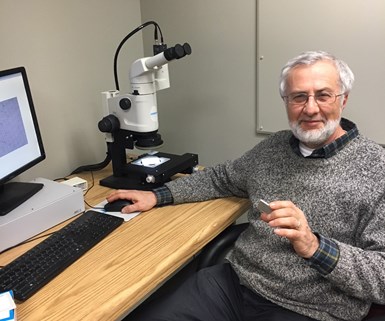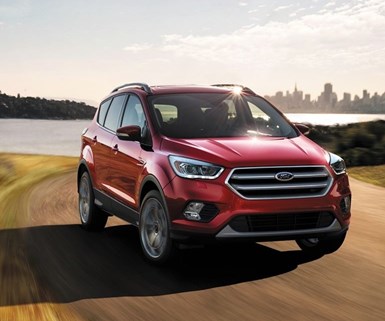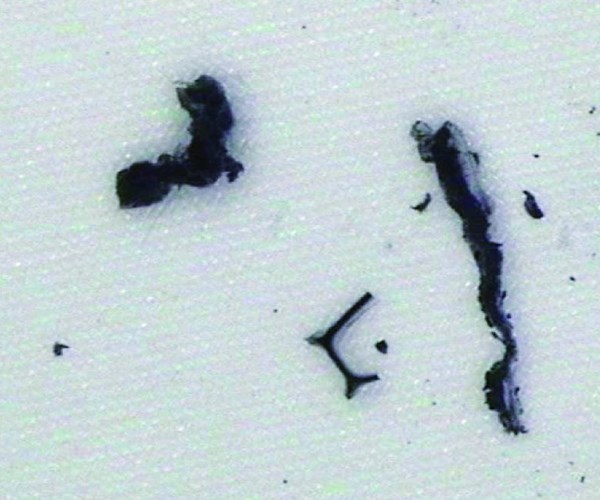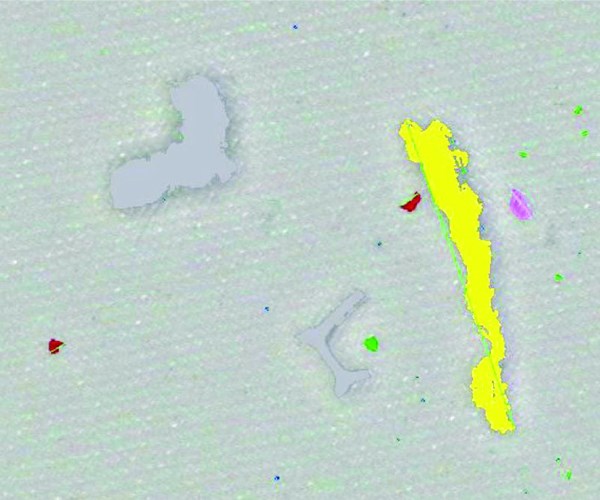
Lev Pekarsky, technical expert, contamination and filtration, Ford Motor Co., uses a cleanliness analysis system that gives a microscopic analysis of particles, automatically recognizing metallic pieces that can’t be seen with the human eye.
Part cleanliness isn’t always a priority in many shops. However, when suppliers are compelled to adhere to cleanliness requirements in order to satisfy their customers, they are more likely to use the equipment and processes necessary to do so.
Although not every shop has been affected by cleanliness specifications, many suppliers to automotive OEMs are already complying with stringent cleanliness standards. North American OEMs such as Ford Motor Co., and in turn, their suppliers, have been required to comply with ISO 16232 standard since 2005, when it was first put into effect.
“All automatic transmissions use precision manufactured electro-hydraulic components with very small clearances,” says Lev Pekarsky, technical expert, contamination and filtration, Ford Motor Co. “Presence of even small-sized debris in those systems could cause degradation of transmission function such as shift engagement quality. That is the reason Ford and our competitors have been continuously improving cleanliness of all transmission components.”
As part of its long-standing culture of global competitiveness and fiscal responsibility, Ford says, it began developing its own contamination engineering requirements or specifications in 2001. The Ford specifications are based on the German automotive standard, VDA 19, which is what ISO 16232 requirements are based on. Ford’s engineering specifications include exceptions to the ISO standards and answer additional questions that are required to integrate ISO into the Ford Production Quality System.
Mr. Pekarsky says Ford’s specs are detailed. “They answer questions such as what solvents to use, what is the parts collection process, and what is a part’s disposition (scrap or reuse) after inspection.” He says they also tell the user what the special extraction (wash down) procedures are for individual sub-assemblies, and they explain how to calibrate a scanning electron microscope (SEM) for material identification.
Mr. Pekarsky explains that most OEMs including Ford conduct regular contamination inspection of transmission components in production using Transmission Plant Contamination Labs. The Ford Transmission and Driveline engineering organization also has its own Product Development Contamination Lab in Livonia, Michigan, that is responsible for developing new, advanced contamination inspection procedures and supporting special investigations.
Ford specs include different stipulations for different types of transmissions. The small parts that make up the transmissions, such as valves, springs and gears, are also tested for particle contamination mostly by Ford suppliers prior to shipping. Very detailed specification documents not only contain inspection process descriptions, but also include requirements for inspection system cleanliness prior to testing. Requirements defining the maximum number of particles and corresponding particle sizes for different types of components being tested are also included in the Ford specifications.
Transmission Plant Contamination Lab inspectors rely on the company’s contamination specifications to do its job every day, Ford says, and following these standards saves money on warranties and rejected parts.
Evolutionary Requirements
Ford says its contamination specs, along with other OEMs, have evolved through the years and continue to be updated when new contamination inspection technology becomes available. The first specs written by Ford engineers many years ago were based on gravimetric methodology, or the weight of debris on a component. Gravimetric requirements ensured that clean filters are weighed prior to debris collection and “dirty filters” after debris collection. The “after minus prior” filter weight difference had to adhere to specific requirements, Ford says. Most of the parts in the transmission were required to be tested.
Then, about 10 years ago, optical detection came into play. It became possible to use automated microscopes to capture and analyze digital images of debris collected from manufactured parts.
“The software (that was packaged with the microscopes) became so sophisticated that it now can differentiate between filter background and individual debris, identify metallic and non-metallic materials and measure their sizes and calculate quantities,” Mr. Pekarsky says.
Around 2013, the Livonia lab began using cleanliness analyzing microscopes by Jomesa North America Inc. These microscopes are designed and produced solely for microscopic filter analysis.
Jomesa has since introduced optical systems to Ford’s contamination labs using hardware and software to detect metallic particles using a patented automatic polarization method.
A Strong Partnership

This filter analysis shows magnified particles using Jomesa’s HFD cleanliness analysis system.
Since 2010, Ford and Jomesa have been working together to develop standards for Ford to first follow internally, according to Peter Feamster, product management director, Jomesa North America. Ford Engineers developed standards and debris particle size limits based on Ford’s own cleanliness manufacturing processes. Then, over the past two to three years, Ford started cascading these standards on its suppliers to follow as well.
The Ford specs are not Jomesa specific, but they reference Jomesa models as examples of ISO/Ford engineering specification compliant systems, Ford says.
Not all particles are easy to detect and measure, however. “The biggest challenge of optical systems is when you have a white or translucent particle, say aluminum oxide or glass. They can’t be detected by an optical microscope,” Mr. Pekarsky says. “Ford and a few Ford suppliers introduced the use of automated SEM in addition to automated optical microscopy (AOM) for contamination inspection of the most critical components.”
According to Mr. Feamster, Jomesa has developed a Ford-specific database for suppliers to report the cleanliness data in a standard way that engineers can analyze efficiently. “This system was designed to be common among all Ford suppliers, so they are all looking at the same information across the board.”
Microscopes Designed with Cleanliness in Mind
Ford houses two Jomesa AOMs per transmission contamination lab, Mr. Feamster says. There are four labs located in North America, plus one in China and one in Mexico.
Unlike other inspection equipment suppliers, Jomesa only designs its systems for technical cleanliness analysis. Jomesa is dedicated to this specific industry niche and focuses all its efforts on constant improvement.
The microscope software by Jomesa that is responsible for the measurement and recording, called PicEd, is continuously being updated and improved. It also has free upgrades, and anyone around the globe can download the latest version without service contracts. The Ford plants in China and Mexico have the same access to the same software in North America.
Mr. Feamster says based on Ford user feedback, automation is a favorite feature, much because the systems are so easy to use. The microscopes are CNC and feature a digital camera. “The system can be mastered by anyone who is not super skilled in microscopy,” he says. “Users only need to follow instructions and go through a small amount of training.”
The systems allow review and editing of test results. All edits are logged to facilitate audits of the testing process.
Customer support and training are the highest priority for Jomesa North America, according to Mr. Feamster. If there are complaints about something or suggestions to improve, the company implements changes based on this feedback.
Clean Parts are Critical

Cleaning standards in the automotive manufacturing process have reaped rewards. Warranty claims have declined, while warranty periods have increased. Today’s cars are manufactured better than ever before.
When purchasing a new car, most buyers don’t think about how the cleanliness of the transmission and engine components can affect the way the car operates. Twenty years ago, after car owners had something go wrong with their cars, they may not have known that the issue was caused by dirt particles that may have already been present in their car’s parts when they bought a new car. Companies such as Ford and Jomesa that are working behind the scenes to improve cleanliness specifications and part cleanliness inspection are helping car buyers get a lot more mileage out of their investment these days. More time between oil changes and less maintenance in general can be attributed to cleaner parts in transmissions and engines.
Cleaning standards in the manufacturing process have reaped financial rewards. Warranty claims have declined, while warranty periods have increased. In other words, today’s cars are manufactured better than ever before.
Related Content
A ‘Clean’ Agenda Offers Unique Presentations in Chicago
The 2024 Parts Cleaning Conference, co-located with the International Manufacturing Technology Show, includes presentations by several speakers who are new to the conference and topics that have not been covered in past editions of this event.
Read MoreMeeting Stringent Cleaning Goals With Modular Ultrasonic System
A knee implant manufacturer implements an advanced cleaning system that meets its tight cleaning requirements, including documenting, validating and tracing the entire cleaning process.
Read MoreParts Cleaning Sector Shifts Energy Toward Regulatory Changes
With changes in EPA regulations regarding the use of some popular cleaning fluids, cleaning suppliers and end users are readjusting business strategies and/or cleaning processes to meet new requirements.
Read MoreKyzen Solvents Provide Safe Parts Cleaning
The SLV901 and SLV803 solvents are formulated to maintain cleaning efficacy while providing a safe, environmentally friendly alternative to processes that use PFAS and HFCs.
Read MoreRead Next
Do You Have Single Points of Failure?
Plans need to be in place before a catastrophic event occurs.
Read MoreA Tooling Workshop Worth a Visit
Marubeni Citizen-Cincom’s tooling and accessory workshop offers a chance to learn more about ancillary devices that can boost machining efficiency and capability.
Read MoreEmerging Leaders Nominations Now Open
Here’s your chance to highlight a young person in your manufacturing business who is on the path to be a future leader moving your company forward.
Read More


























